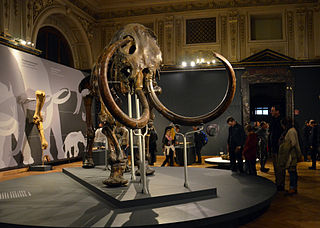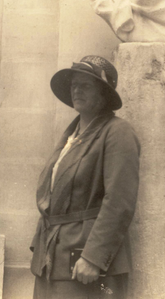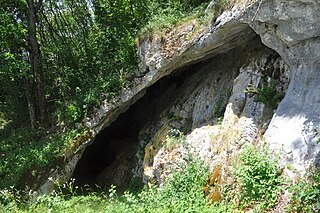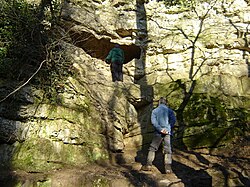
Hyenas, or hyaenas, are feliform carnivoran mammals of the family Hyaenidae. With only four extant species, it is the fifth-smallest biological family in the Carnivora and one of the smallest in the class Mammalia. Despite their low diversity, hyenas are unique and vital components of most African ecosystems.

Jean Léopold Nicolas Frédéric, Baron Cuvier, known as Georges Cuvier, was a French naturalist and zoologist, sometimes referred to as the "founding father of paleontology". Cuvier was a major figure in natural sciences research in the early 19th century and was instrumental in establishing the fields of comparative anatomy and paleontology through his work in comparing living animals with fossils.

The Red Lady of Paviland is an Upper Paleolithic partial skeleton of a male dyed in red ochre and buried in Britain 33,000 BP. The bones were discovered in 1823 by William Buckland in an archaeological dig at Goat's Hole Cave — one of the limestone caves between Port Eynon and Rhossili on the Gower Peninsula, Swansea, south Wales.

William Buckland DD, FRS was an English theologian who became Dean of Westminster. He was also a geologist and palaeontologist.

A coprolite is fossilized feces. Coprolites are classified as trace fossils as opposed to body fossils, as they give evidence for the animal's behaviour rather than morphology. The name is derived from the Greek words κόπρος and λίθος. They were first described by William Buckland in 1829. Before this, they were known as "fossil fir cones" and "bezoar stones". They serve a valuable purpose in paleontology because they provide direct evidence of the predation and diet of extinct organisms. Coprolites may range in size from a few millimetres to over 60 centimetres.

Flood geology is a pseudoscientific attempt to interpret and reconcile geological features of the Earth in accordance with a literal belief in the global flood described in Genesis 6–8. In the early 19th century, diluvial geologists hypothesized that specific surface features provided evidence of a worldwide flood which had followed earlier geological eras; after further investigation they agreed that these features resulted from local floods or from glaciers. In the 20th century, young-Earth creationists revived flood geology as an overarching concept in their opposition to evolution, assuming a recent six-day Creation and cataclysmic geological changes during the biblical flood, and incorporating creationist explanations of the sequences of rock strata.

Għar Dalam is a 144 metre long phreatic tube and cave, or cul-de-sac, located in the outskirts of Birżebbuġa, Malta. The cave contains the bone remains of animals that were stranded and subsequently became extinct in Malta at the end of the Last Glacial Maximum. It has lent its name to the Għar Dalam phase in Maltese prehistory, and is viewed as one of Malta's most important national monuments. Pottery similar to that found in Stentinello was found at Għar Dalam, but lacking details such as stamp decorations.

The history of paleontology traces the history of the effort to understand the history of life on Earth by studying the fossil record left behind by living organisms. Since it is concerned with understanding living organisms of the past, paleontology can be considered to be a field of biology, but its historical development has been closely tied to geology and the effort to understand the history of Earth itself.

The cave hyena, also known as the Ice Age spotted hyena, was a paleosubspecies of spotted hyena which ranged from the Iberian Peninsula to eastern Siberia. It is one of the best known mammals of the Ice Age and is well represented in many European bone caves. The cave hyena was a highly specialised animal, with its progressive and regressive features being more developed than in its modern African relative. It preyed on large mammals, and was responsible for the accumulation of hundreds of large Pleistocene mammal bones in areas including horizontal caves, sinkholes, mud pits and muddy areas along rivers.

The Adams mammoth is the first woolly mammoth skeleton with skin and flesh still attached to be recovered by scientists. The mostly complete skeleton and flesh were discovered in 1799 in northeastern Siberia by Ossip Shumachov, an Evenki hunter and subsequently recovered in 1806 when Russian botanist Mikhail Adams journeyed to the location and collected the remains.

Dorothea Minola Alice Bate FGS, also known as Dorothy Bate, was a Welsh palaeontologist and pioneer of archaeozoology. Her life's work was to find fossils of recently extinct mammals with a view to understanding how and why giant and dwarf forms evolved.

Duria Antiquior, a more ancient Dorset, was the first pictorial representation of a scene of prehistoric life based on evidence from fossil reconstructions, a genre now known as paleoart. The first version was a watercolour painted in 1830 by the English geologist Henry De la Beche based on fossils found in Lyme Regis, Dorset, mostly by the professional fossil collector Mary Anning. De la Beche had the professional artist Georg Scharf produce lithographic prints based on the painting, which he sold to friends to raise money for Anning's benefit. It was the first depiction of a scene from deep time to see even limited publication. The print was used for educational purposes and widely circulated in scientific circles; it influenced several other such depictions that began to appear in both scientific and popular literature. Several later versions were produced.
Wolves were once present in Great Britain. Early writing from Roman and later Saxon chronicles indicate that wolves appear to have been extraordinarily numerous on the island. Unlike other British animals, wolves were unaffected by island dwarfism, with certain skeletal remains indicating that they may have grown as large as Arctic wolves. The species was exterminated from Britain through a combination of deforestation and active hunting through bounty systems.

Betal Rock Shelter, a karst cave located on the south-eastern edge of the Lower Pivka river valley on a slope just above the road from Postojna to Bukovje is a site where rich cultural sediment layers with remains of stone tools, artifacts, and numerous fossilized bones of contemporary animals were found. Its entrance was formed by the collapse of the 174 m (571 ft) long cave's ceiling, carved out by the waters of the Pivka River.

Phascolotherium is a genus of extinct eutriconodont mammal from the Middle Jurassic of the United Kingdom. Found in the Stonesfield Slate, it was one of the first Mesozoic mammals ever found and described, although like the other mammal jaws found at the same time, it was mistakenly thought at first to be a marsupial.

The Cave of Aurignac is an archaeological site in the commune of Aurignac, Haute-Garonne department in southwestern France. Sediment excavation and artefact documentation since 1860 confirm the idea of the arrival and permanent presence of European early modern humans during the Upper Palaeolithic. The eponymous location represents the type site of the Aurignacian, the earliest known culture attributed to modern humans in western Eurasia. Assemblages of Aurignacian tool making tradition can be found in the cultural sediments of numerous sites from around 45,000 years BP to around 26,000 years BP. In recognition of its significance for various scientific fields and the 19th-century pioneering work of Édouard Lartet the Cave of Aurignac was officially declared a national Historic Monument of France by order of May 26, 1921.
Dream Cave is a natural limestone cavern located near Wirksworth in Derbyshire, England. It was discovered by lead miners in 1822 and was found to contain the almost complete skeletal remains of a woolly rhinoceros and other large mammal bones. These remains were acquired by the geologist William Buckland and are now housed in Oxford Museum.
Jules de Christol was a French paleontologist and geologist who identified the fossil horse ancestor Hipparion. He was among the first French zoologists to suggest the existence of human remains that were "antediluvian", older than the supposed Biblical flood, contrary to the dominant view of earth history at the time.

The Armley Hippo, previously known as the Leeds Hippopotamus, is the greater part of the fossil skeleton of a great northern hippopotamus consisting of 122 bones, of which 25 were taxidermy-mounted in 2008 by James Dickinson for display at Leeds City Museum in Leeds, West Yorkshire, England. The skeleton may be as much as 130,000 years old. The species it represents has been extinct in the United Kingdom since prehistoric times.


















